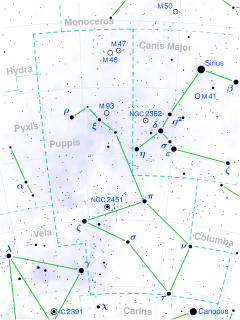
Delta Sculptoris is a triple star system in the constellation Sculptor. It is approximately 137.4 light years from Earth.

72 Ophiuchi is a binary star system in the equatorial constellation of Ophiuchus. It is visible to the naked eye as a faint, white-hued point of light with a combined apparent visual magnitude of 3.73. It is located approximately 86.9 light years away from the Sun based on parallax, but is moving closer with a heliocentric radial velocity of -23.9 km/s.

γ Monocerotis, Latinised as Gamma Monocerotis, is a binary star system in the equatorial constellation of Monoceros. Based upon an annual parallax shift of 6.55 mas, it is located roughly 500 light years from the Sun. It can be viewed with the naked eye, having an apparent visual magnitude of 3.96. Gamma Monocerotis is moving away from the Sun with a radial velocity of −5 km/s.
Lambda Cygni is a class B5V star in the constellation Cygnus. Its apparent magnitude is 4.54 and it is approximately 770 light years away based on parallax.

Nu Cygni, Latinized from ν Cygni, is a binary star system in the constellation Cygnus. Its apparent magnitude is 3.94 and it is approximately 374 light years away based on parallax. The brighter component is a magnitude 4.07 A-type giant star with a stellar classification of A0III n, where the 'n' indicates broad "nebulous" absorption lines due to rapid rotation. This white-hued star has an estimated 3.6 times the mass of the Sun and about 1.9 times the Sun's radius. It is radiating 412 times the Sun's luminosity from its photosphere at an effective temperature of 9,462 K. The magnitude 6.4 companion has an angular separation of 0.24" from the primary.
Iota Leporis is a triple star system in the southern constellation of Lepus. It is visible to the naked eye as a point source of blue-white light with an apparent visual magnitude of 4.45. Based upon an annual parallax shift of 14.07 mas as measured from Earth, the system is located roughly 232 light years from the Sun.

Phi Ophiuchi, a name Latinized from φ Ophiuchi, is a single star in the equatorial constellation of Ophiuchus. It has a yellow hue and is faintly visible to the naked eye with an apparent visual magnitude of 4.27. The star is located at a distance of approximately 244 light-years from the Sun based on parallax, but it is drifting closer with a radial velocity of −33.5 km/s.

35 Pegasi is a single star in the northern constellation of Pegasus. It is visible to the naked eye as a faint, orange-hued point of light with an apparent visual magnitude of 4.80. The star is located approximately 155 light years away from the Sun based on parallax, and is drifting further away with a radial velocity of +54 km/s. The star has a relatively high proper motion, traversing the celestial sphere at the rate of 0.318 arc seconds per annum.

Epsilon Phoenicis is a star in the constellation Phoenix. Its apparent magnitude is 3.87. Located around 144 light-years (44 pc) distant, it is an orange giant of spectral type K0III, a star that has used up its core hydrogen and has expanded.

HD 63922 is a class B0III star in the constellation Puppis. Its apparent magnitude is 4.11 and it is approximately 1600 light years away based on parallax.

HD 69142 is a class K1II-III star in the constellation Puppis. Its apparent magnitude is 4.44 and it is approximately 298 light years away based on parallax.

QW Puppis is a class F3V star in the constellation Puppis. Its apparent magnitude is 4.49 and it is approximately 69.9 light years away based on parallax.

HD 61330 is a class B8IV star in the constellation Puppis. Its apparent magnitude is 4.53 and it is approximately 360 light years away based on parallax.

HD 65810 is a class A2V star in the constellation Puppis. Its apparent magnitude is 4.61 and it is approximately 241 light years away based on parallax.

HD 60863 is a class B8V star in the constellation Puppis. Its apparent magnitude is 4.65 and it is approximately 222 light years away based on parallax.

PU Puppis is a class B8III star in the constellation Puppis. Its apparent magnitude is 4.69 and it is approximately 620 light years away based on parallax.

HD 63744 is a class K0III star in the constellation Puppis. Its apparent magnitude is 4.71 and it is approximately 232 light years away based on parallax.

HD 70555 is a class K2.5II-III star in the constellation Puppis. Its apparent magnitude is 4.83 and it is approximately 1,010 light years away based on parallax.

52 Sagittarii is a binary star system in the southern constellation of Sagittarius. It has the Bayer designation h2 Sagittarii, while 52 Sagittarii is the Flamsteed designation. This system is visible to the naked eye as a faint, blue-white hued point of light with an apparent visual magnitude of 4.59. It is located approximately 190 light years away based on parallax, but is drifting closer with a radial velocity of −19 km/s.

HD 165634 is a star in the southern constellation of Sagittarius. It has a yellow hue and is faintly visible to the naked eye with apparent visual magnitude of 4.56. The star is located at a distance of approximately 339 light years from the Sun based on parallax, but is drifting closer with a radial velocity of −5 km/s. It has an absolute magnitude of −0.53.








